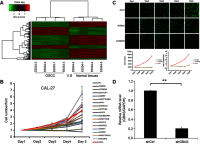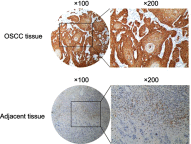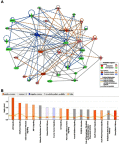Downregulation of GBAS regulates oral squamous cell carcinoma proliferation and apoptosis via the p53 signaling pathway
- PMID: 31190874
- PMCID: PMC6529179
- DOI: 10.2147/OTT.S207930
Downregulation of GBAS regulates oral squamous cell carcinoma proliferation and apoptosis via the p53 signaling pathway
Abstract
Purpose: Oral squamous cell carcinoma (OSCC) is the most common and severe type of head and neck malignancy. The mechanisms by which OSCC arises depend on changes in a number of different factors and genes and the clinicopathological stage of the tumors. Better understanding the possible mechanisms of OSCC would help to identify a new target for molecular targeted therapy. The current study was focused on elucidating the significance of the glioblastoma-amplified sequence (GBAS) on malignant behaviors in OSCC, including proliferation and apoptosis. Patients and methods: In this study, we measured the levels of mRNA in OSCC and normal oral tissue samples using Affymetrix microarrays. We examined GBAS expression in OSCC tissues and the effect of GBAS knockdown on cell proliferation and apoptosis in vitro and in vivo. The mechanisms underlying GBAS were investigated. Results: In the present study, GBAS expression was substantially elevated in the majority of tested OSCC tissues. Further, knockdown of GBAS using lentiviral-delivered shRNA in cells had significant effects on cell proliferation, apoptosis and the cell cycle. A xenograft model was also used to assess the tumorigenicity of the GBAS knockdown on OSCC cells in vivo. Mechanistically, GBAS activated p53 signaling by regulating the mRNA and protein expression of CHEK1, AKT1, AKT2 and Bax. Finally, we also investigated the expression of GBAS in patients with OSCC, and the data revealed that GBAS expression was correlated with the rates of relapse and tumor grade. Conclusion: Our studies provide evidence that GBAS regulates OSCC cell proliferation and apoptosis via p53 signaling, which may be a candidate biomarker for the prognosis and treatment of OSCC.
Keywords: GBAS; apoptosis; oral squamous cell carcinoma; p53 signaling pathway.
Conflict of interest statement
The authors report no conflicts of interest in this work.
Figures







Similar articles
-
GBAS Regulates the Proliferation and Metastasis of Ovarian Cancer Cells by Combining with eEF1A1.Oncologist. 2022 Feb 3;27(1):e64-e75. doi: 10.1093/oncolo/oyab015. Oncologist. 2022. PMID: 35305106 Free PMC article.
-
NAD-dependent methylenetetrahydrofolate dehydrogenase inhibits oral squamous cell carcinoma cell proliferation and promotes apoptosis.Transl Cancer Res. 2021 Mar;10(3):1457-1469. doi: 10.21037/tcr-20-2798. Transl Cancer Res. 2021. PMID: 35116471 Free PMC article.
-
LncRNA AC007271.3 promotes cell proliferation, invasion, migration and inhibits cell apoptosis of OSCC via the Wnt/β-catenin signaling pathway.Life Sci. 2019 Dec 15;239:117087. doi: 10.1016/j.lfs.2019.117087. Epub 2019 Nov 20. Life Sci. 2019. PMID: 31759044
-
LncRNA, TUG1 regulates the oral squamous cell carcinoma progression possibly via interacting with Wnt/β-catenin signaling.Gene. 2017 Apr 15;608:49-57. doi: 10.1016/j.gene.2017.01.024. Epub 2017 Jan 22. Gene. 2017. PMID: 28119088
-
Effect of Lycopene on Oral Squamous Cell Carcinoma Cell Growth by Inhibiting IGF1 Pathway.Cancer Manag Res. 2021 Jan 26;13:723-732. doi: 10.2147/CMAR.S283927. eCollection 2021. Cancer Manag Res. 2021. PMID: 33531840 Free PMC article.
Cited by
-
GBAS Regulates the Proliferation and Metastasis of Ovarian Cancer Cells by Combining with eEF1A1.Oncologist. 2022 Feb 3;27(1):e64-e75. doi: 10.1093/oncolo/oyab015. Oncologist. 2022. PMID: 35305106 Free PMC article.
-
Association between decreased p53 expression, elevated serum CagA levels, and oral squamous cell carcinoma.Clinics (Sao Paulo). 2025 Apr 2;80:100632. doi: 10.1016/j.clinsp.2025.100632. eCollection 2025. Clinics (Sao Paulo). 2025. PMID: 40179525 Free PMC article.
-
Effect of ALA-PDT on inhibition of oral precancerous cell growth and its related mechanisms.Lasers Med Sci. 2022 Dec;37(9):3461-3472. doi: 10.1007/s10103-022-03607-y. Epub 2022 Jul 7. Lasers Med Sci. 2022. PMID: 35796919
-
NAD-dependent methylenetetrahydrofolate dehydrogenase inhibits oral squamous cell carcinoma cell proliferation and promotes apoptosis.Transl Cancer Res. 2021 Mar;10(3):1457-1469. doi: 10.21037/tcr-20-2798. Transl Cancer Res. 2021. PMID: 35116471 Free PMC article.
-
Botanical Drug Puerarin Ameliorates Liposaccharide-Induced Depressive Behaviors in Mice via Inhibiting RagA/mTOR/p70S6K Pathways.Oxid Med Cell Longev. 2021 Oct 18;2021:7716201. doi: 10.1155/2021/7716201. eCollection 2021. Oxid Med Cell Longev. 2021. PMID: 34707778 Free PMC article.
References
-
- Global Burden of Disease Cancer Collaboration; Fitzmaurice C, Akinyemiju TF, et al. Global, regional, and national cancer incidence, mortality, years of life lost, years lived with disability, and disability-adjusted life-years for 29 cancer groups, 1990 to 2016 a systematic analysis for the global burden of disease study. JAMA Oncol. 2018;4(11):1553–1568. doi:10.1001/jamaoncol.2017.4473 - DOI - PMC - PubMed
LinkOut - more resources
Full Text Sources
Research Materials
Miscellaneous

